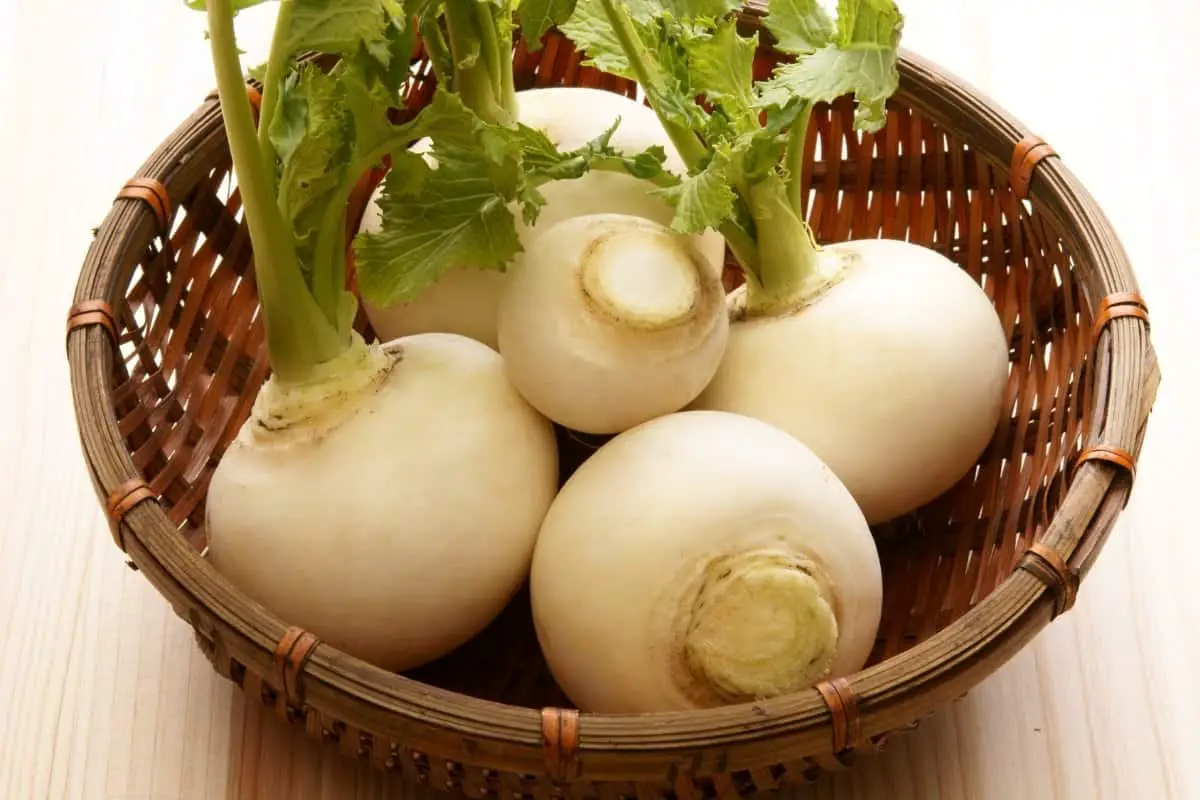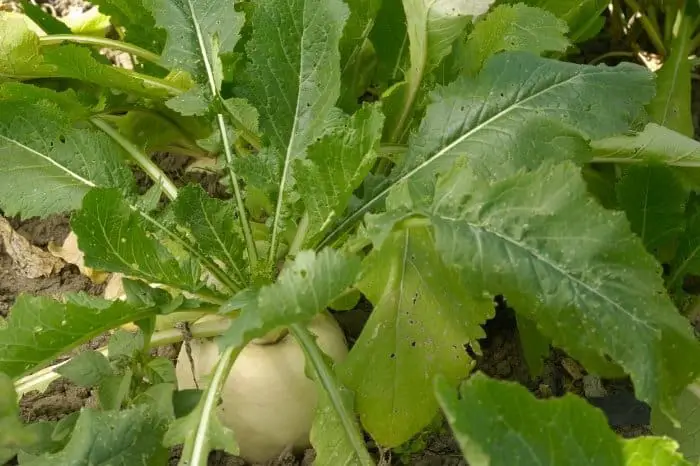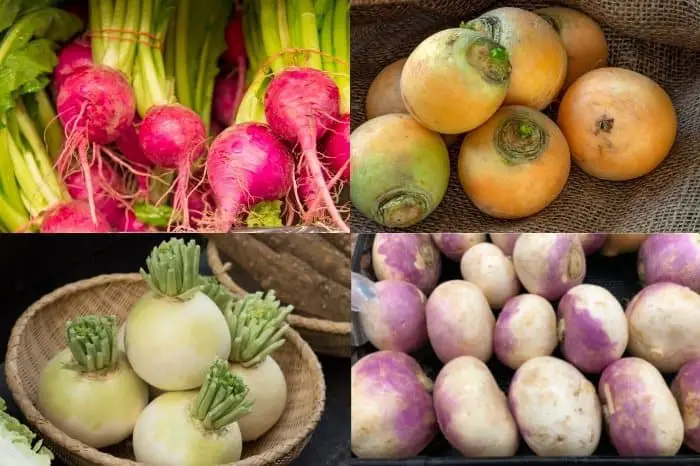Last Updated on February 6, 2022 by
This article will cover how to grow turnips, how to nurture them, and, most importantly, how long turnips take to succeed.
Turnips are root vegetables, small in size and oval in shape. They have a whitish underbelly with either a green or purple top but remain white inside.
Most gardeners are familiar with the white and purple tennis turnips commonly sold in grocery stores. However, there is a good deal of variety beyond these two types. They include small, tender radish-sized turnips.
Turnips are in the Brassicaceae family, and their edible green tops have a flavor similar to mustard greens. These vegetables are delicious when eaten raw, roasted, or added to stews. You can also cook the leaves the same way you do with kale.
This versatile vegetable is best grown across all seasons. They are best planted from seeds in early spring or the fall, at least 70 days before the first frost. They mature in about 2 months from the day of planting.
Growing Turnips
When growing your turnips, there are several critical elements you need to consider. Let’s look at the right condition to grow these root vegetables.
Location
Turnips are best grown in full or partial shade. Plant your turnips in well-drained soil rich in organic matter that has a soil pH of 5.5 to 6.8. Prepare your planting beds in advance and apply garden compost or well-aged manure. If your soil is heavy or clay soil, add sand or gypsum when preparing beds. Do all this a season before seeding.
Planting Time
Plant turnip seeds directly into your garden 2 to 3 weeks before the average last frost date in spring. This will give you a late spring or early summer harvest. Plant them in late summer and harvest in autumn. Plant in early autumn and harvest in late autumn. And for winter harvest, plant in late autumn.
Seeds Or Transplants
Although nursery transplants are available, most people prefer to sow turnips directly in the garden. You can sow them either early spring, late summer, or early fall, about 70 days before the first frost date.
Planting And Spacing
Turnips do not transplant well; rather, they grow very well when sown directly in the garden.
Sow your seeds about ½ inch deep and thin them when they are 3 to 4 inches tall, leaving them at least 2 to 4 inches apart. You can grow your turnips in wide rows of about 4 to 6 inches apart. You can use the thinned plants as edible greens. They are soft and yummy.
How Long Do Turnips Take To Grow?
Like their cousins, beets and turnips are versatile crops that you can grow for greens or roots.
Turnips are a cool-weather crop. They require about 30 to 60 days from planting to harvesting. They grow very quickly and mature in about 2 months; this means you can get more than a harvest in a season. They thrive in temperatures from 40°F to 75°F. Harvest them before temperatures exceed 75°F (24°C).
For a prolonged harvest, you can grow succession plants every 10 to 14 days.
Turnips Grow Care
Now that you have planted them in the right conditions, its time to give them the proper care that includes
-
Light – Turnips love to grow under the full sun but can also thrive in part shade.
-
Soil – The soil should be fertile and well-draining with a slightly acidic pH of 6.0 to 6.5. Ensure your soil is well-drained to protect the roots from root rot. Rich, fertile soil will help them grow quickly.
-
Water – Provide at least 1 inch of water each week for good root development. Turnips grow fast and regular watering plus rich fertile soil helps them do that. A dryer climate makes the roots more pungent, while proper watering gives them a good flavor.
-
Temperature– Turnips thrive in the cool weather of spring or fall.
-
Fertilizer – Turnips grow quickly, so there is no need to add fertilizer to the turnip plants in most cases. Just fertilize the soil with plenty of organic matter before sowing your seeds.
Dr. Earth Organic 5 Tomato, Vegetable & Herb Fertilizer Poly Bag
Pests And Diseases
Turnips are not affected by the usual diseases and pests associated with growing Brassicas. The common ones include clubroot, Rhizoctonia rot, anthracnose, scab, leaf spot, turnip mosaic virus, root-knot, and white rust.
To prevent any of these diseases from affecting your turnips, avoid planting them in the same place you had planted Brassica species in the last 2 years.
The common pests include flea beetles and aphids. These damages the greens preventing them from proper growth. You can use row covers to keep them off the leaves. Wireworms and root maggots damage the bulbs.
Turnips Varieties To Grow
-
Tokyo Cross – An AAS winner – it grows quickly and very uniformly maturing in only 35 days. This type is slow to turn pithy, meaning you can enjoy it for longer.
-
Alltop is commonly grown for its greens and matures in 35 days. It will re-sprout quickly after the greens are harvested.
-
Golden Ball features sweet yellow bulbs with a small, faint almond taste maturing in 60 days.
-
Shogoin is grown for its broad and mild greens, but its root is also great. It matures in 45 days only.
-
Purple Top White Globe is a popular type and grows so well, maturing in 55 days.
-
Scarlet Queen matures in 45 days and is bright red on the outside with the white inside. It is slow to turn pithy and can be used for longer.
Harvesting Turnips
-
Greens. You can harvest turnip greens after they reach at least 4 inches tall. If you don’t harm the top of the root structure, the greens will regrow.
-
Roots. The roots are best harvested and eaten when small and tender, around 2 to 3 inches in diameter. Do not allow them to get old to avoid them growing tough, pithy, or bitter.
FAQs
How do you know when your turnips are ready to harvest?
A turnip can be planted in spring or fall and will grow in three weeks.They are ready to harvest when the tops begin to turn brown and dry out. When they're ready to be harvested, you can just pull them up and they will root easily. They do well in most soils as long as the soil is rich. I have used a combination of compost and blood meal with good results, and I also have had success with garden soil and a light layer of compost. You can now them directly into the garden, but you can use a small pot or flats if you prefer.
What month do you plant turnips?
Turnips should be planted at the beginning of the spring season. The seeds should be planted about four inches deep and three inches apart in rows that are three feet apart. Once the plants have two or three sets of leaves, they can be thinned out to make room for other vegetables. Harvest the roots when they are about three to four inches long. If you don't harvest your turnips regularly, they will not become very large.
If you want to grow them for market, then June is a good time. They will be ready to harvest in about a week. If you are growing them for the table, then you should try and harvest them when they are still small. You can eat them raw or cook them like potatoes.
How long does it take to grow turnips?
Turnips should be planted at the beginning of the spring season. The seeds should be planted about four inches deep and three inches apart in rows that are three feet apart. Once the plants have two or three sets of leaves, they can be thinned out to make room for other vegetables. Harvest the roots when they are about three to four inches long. If you don't harvest your turnips regularly, they will not become very large.
As with any vegetable, there is also a great deal of variety in the size and shape of turnips. The varieties that grow larger tend to be more robust and have stronger roots and stalks than smaller varieties. Turnips can be harvested at any stage, but they are best when they are young, tender, and still growing. They can be stored in a root cellar or refrigerator for up to three months.
How often should you water turnips?
Turnips are easy to grow. They are the only root crop that does well in cool weather and can be planted as early as mid-May. They will produce for about a month, but the quality of the root is best when they are harvested after 3 or 4 weeks. In my experience, turnips should be watered twice a week if grown in warm weather, but once a week if the weather is cooler.
Conclusion
FAQs
How do you know when your turnips are ready to harvest?
A turnip can be planted in spring or fall and will grow in three weeks.They are ready to harvest when the tops begin to turn brown and dry out. When they're ready to be harvested, you can just pull them up and they will root easily. They do well in most soils as long as the soil is rich. I have used a combination of compost and blood meal with good results, and I also have had success with garden soil and a light layer of compost. You can now them directly into the garden, but you can use a small pot or flats if you prefer.
What month do you plant turnips?
Turnips should be planted at the beginning of the spring season. The seeds should be planted about four inches deep and three inches apart in rows that are three feet apart. Once the plants have two or three sets of leaves, they can be thinned out to make room for other vegetables. Harvest the roots when they are about three to four inches long. If you don't harvest your turnips regularly, they will not become very large.
If you want to grow them for market, then June is a good time. They will be ready to harvest in about a week. If you are growing them for the table, then you should try and harvest them when they are still small. You can eat them raw or cook them like potatoes.
How long does it take to grow turnips?
Turnips should be planted at the beginning of the spring season. The seeds should be planted about four inches deep and three inches apart in rows that are three feet apart. Once the plants have two or three sets of leaves, they can be thinned out to make room for other vegetables. Harvest the roots when they are about three to four inches long. If you don't harvest your turnips regularly, they will not become very large.
As with any vegetable, there is also a great deal of variety in the size and shape of turnips. The varieties that grow larger tend to be more robust and have stronger roots and stalks than smaller varieties. Turnips can be harvested at any stage, but they are best when they are young, tender, and still growing. They can be stored in a root cellar or refrigerator for up to three months.
How often should you water turnips?
Turnips are easy to grow. They are the only root crop that does well in cool weather and can be planted as early as mid-May. They will produce for about a month, but the quality of the root is best when they are harvested after 3 or 4 weeks. In my experience, turnips should be watered twice a week if grown in warm weather, but once a week if the weather is cooler.
You can harvest your fall-planted turnips in the winter. Since they no longer actively grow in the winter, cover them with a layer of mulch to prevent them from freezing, and the cold weather will sweeten them even more.
You have no reason not to grow your own turnips; they are easy plants that grow fast.
Caroline is a gardener who loves to get down to the nitty–gritty of gardening. She proudly proclaims herself as a ‘dirt worshipper‘ and can often be found deep in the garden, covered in soil and singing to her plants. As a self–proclaimed ‘plant whisperer‘, Caroline believes that plants need love and attention just like any other living thing, and she loves to give them both. When she‘s not tending to her garden, you can often find her researching the latest gardening trends, or teaching others how to make their gardens thrive





